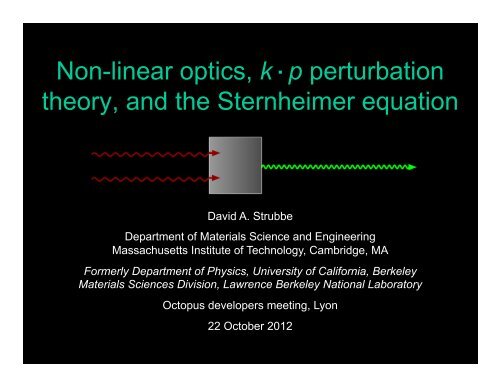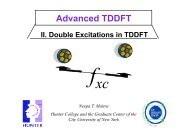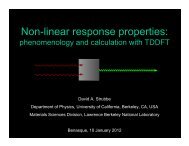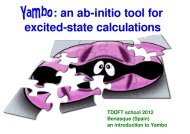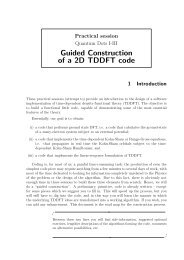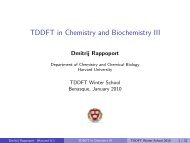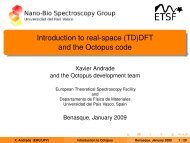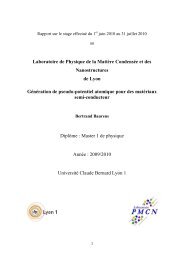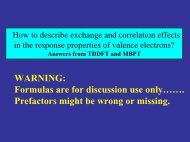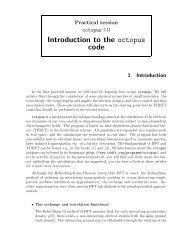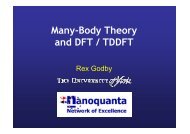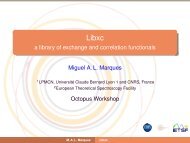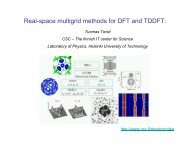Sternheimer equation - TDDFT.org
Sternheimer equation - TDDFT.org
Sternheimer equation - TDDFT.org
Create successful ePaper yourself
Turn your PDF publications into a flip-book with our unique Google optimized e-Paper software.
Non-linear optics, k·p perturbation<br />
theory, and the <strong>Sternheimer</strong> <strong>equation</strong><br />
David A. Strubbe<br />
Department of Materials Science and Engineering<br />
Massachusetts Institute of Technology, Cambridge, MA<br />
Formerly Department of Physics, University of California, Berkeley<br />
Materials Sciences Division, Lawrence Berkeley National Laboratory<br />
Octopus developers meeting, Lyon<br />
22 October 2012
What is non-linear optics?<br />
Polarizability (linear optics)<br />
absorption, refraction<br />
Hyperpolarizability: second-harmonic generation (SHG) etc.<br />
Consider only perturbative processes via Taylor expansion of dipole moment.<br />
Not high-harmonic generation!
Quantized picture of non-linear optics<br />
absorption<br />
two-photon absorption<br />
refraction<br />
second-harmonic generation
Applications<br />
Characterization in surface science and chemistry (very sensitive)<br />
Optical parametric amplifiers<br />
Pockels cells<br />
Laser pointers<br />
Tunable light sources<br />
Optical logic<br />
coherent anti-Stokes Raman spectroscopy (CARS) (kind of 4-wave mixing)<br />
Two-photon fluorescencing labels in biology<br />
Typically in<strong>org</strong>anic crystals are used in applications, but <strong>org</strong>anic molecules<br />
have the potential to be cheaper and more efficient.
Question: How does the liquid environment affect<br />
non-linear optical properties of molecules?<br />
gas-phase EFISH 1.0 ± 4.2 Kaatz et al., J. Chem. Phys. 108, 849 (1998)<br />
liquid EFISH -68 ± 7.0 Kajzar et al., Phys. Rev. A 36, 2210 (1987)<br />
CHCl 3 molecule. Values in atomic units. λ = 1064 nm<br />
Relate experimental<br />
measurements in solution to<br />
intrinsic molecular properties.<br />
Goal: calculations on<br />
snapshots from ab initio<br />
molecular dynamics, in<br />
periodic supercell.
Solution measurements of hyperpolarizability<br />
Measurements are usually in solution for molecules. Solvent effects can be<br />
strong and complicate comparison between experiment and theory.<br />
(In theory, handle via polarizable continuum models or explicit solvent in small<br />
clusters or periodic system.)<br />
(Time-averaged) inversion symmetry of solution makes ordinary<br />
measurement give zero.<br />
Electric-field-induced second-harmonic generation (EFISH) is coherent<br />
third-order process, based on field lining up molecules.<br />
What is measured directly and often reported:<br />
Hyper-Rayleigh scattering (HRS) is incoherent second-order process,<br />
based on orientational fluctuations.
Solution measurements of hyperpolarizability<br />
Consider projection along dipole moment.<br />
Vertical-vertical and horizontal-vertical polarizations for experiment.
Convergence is more demanding for nonlinear response<br />
(aug-cc-pV5Z)<br />
(SIESTA)<br />
(h =0.25, r=22)<br />
F. Vila, D.A. Strubbe, Y. Takimoto, X. Andrade, A. Rubio, S. G. Louie, and J. J. Rehr, J.<br />
Chem. Phys. 133, 034111 (2010)<br />
Comparison of Gaussian-type orbitals, SIESTA numerical<br />
basis sets, real-space grid: need five-zeta basis sets with<br />
diffuse functions, or very long-range real-space grid.<br />
R<br />
Response extends far from molecule (> 15 a 0 )<br />
Compare: only 12 a 0 converges ground state<br />
all atoms contained within 3 a 0 radius
1. Effect of electronic confinement on molecule<br />
exp’t liquid HRS<br />
liquid<br />
gas<br />
exp’t gas EFISH<br />
exp’t liquid EFISH<br />
EFISH (gas) EFISH (liq) HRS VV HRS HV<br />
exp’t 1.0 ± 4.2 -68 ± 7 15.7 ± 0.6 9.9 ± 0.4<br />
calc. -3.47 -51.6 31.0 12.1<br />
R<br />
Consider sphere with molecular volume of liquid.<br />
Confinement increases β EFISH magnitude and brings<br />
close to liquid values
Theoretical methods for nonlinear response in <strong>TDDFT</strong><br />
1. Finite differences (static)<br />
2. Explicit time-propagation<br />
3. <strong>Sternheimer</strong> <strong>equation</strong> (2n+1 Theorem)<br />
4. Sum over states (Casida <strong>equation</strong>)<br />
5. Dyson <strong>equation</strong>
Finite differences<br />
Apply static fields and calculate dipole moment.<br />
No need for special capabilities in code.<br />
Probably most common method used.<br />
Hope static and IR are similar!<br />
fit or stencil<br />
CHCl 3<br />
F. Vila, D.A. Strubbe, Y. Takimoto, X. Andrade, A. Rubio, S. G. Louie, and J. J. Rehr, J.<br />
Chem. Phys. 133, 034111 (2010)
<strong>Sternheimer</strong> <strong>equation</strong><br />
aka density-functional perturbation theory or coupled perturbed Kohn-Sham<br />
S. Baroni, S. de Gironcoli, A. Dal Corso, and P. Gianozzi, Rev. Mod. Phys. 73, 515 (2001)"<br />
Calculate variation of occupied wavefunctions in linear response.<br />
One frequency at a time.<br />
Hartree<br />
XC kernel<br />
SCF cycle: solve linear <strong>equation</strong> for each state, update n (1) and H (1) .<br />
X Andrade, S Botti, MAL Marques, and A Rubio, J. Chem. Phys. 126, 184106 (2007)
<strong>Sternheimer</strong> <strong>equation</strong>: projectors and resonances<br />
Project out unperturbed state to enforce standard phase convention.<br />
Can also project out occupied states for linear density response.<br />
Larger null space: fewer solver iterations.<br />
Need imaginary broadening ω + iη near resonances for numerical stability.<br />
Experiment is broadened anyway.<br />
Allows us to obtain imaginary part<br />
of response as well.<br />
X Andrade, S Botti, MAL Marques, and A Rubio,<br />
J. Chem. Phys. 126, 184106 (2007)
<strong>Sternheimer</strong> <strong>equation</strong>: 2n+1 Theorem<br />
Solving n th -order perturbation theory gives 2n+1 derivative of total energy.<br />
n = 0: Hellman-Feyman Theorem. No wavefunction derivatives at all.<br />
n = 1: Linear variation of wavefunctions gives quadratic response.<br />
X. Gonze and J.-P. Vigneron, Phys. Rev. B 39, 13120 (1989)<br />
Quantum ESPRESSO and Octopus use <strong>equation</strong>s on previous slide.<br />
ABINIT formulation: find β by minimizing with respect to ψ (1) (variational).
Perturbations in <strong>Sternheimer</strong> <strong>equation</strong><br />
Electric field in finite system:<br />
(Can also study response to magnetic fields, ionic displacements, strain, etc.)<br />
Dipole reformulation with quantum theory<br />
of polarization in extended system<br />
A Dal Corso, F Mauri, and A Rubio,<br />
Phys. Rev. B 53, 15638 (1996)<br />
k·p perturbation theory (non-SCF):
Polarization of a periodic system<br />
Linear response can get derivatives<br />
but not the polarization itself.<br />
Berry phase with “strings” of k-points:<br />
Single-point Berry phase (from just the Γ point)<br />
Yaschenko, Fu, Resca, and Resta, PRB 58, 1222 (1998)
Si k.p perturbation
Si dielectric constant<br />
LDA, static: 12.87 vs. 13.1 in literature (“60 special k-points”)<br />
ZH Levine and DC Allan, Phys Rev Lett 63, 1719 (1989)
Vibrational / rotational contributions<br />
Many measurements are at λ = 1064 nm. For <strong>org</strong>anic molecules, typically:<br />
- above vibrational frequencies, so can neglect vibrations<br />
- below electronic resonances so little dispersion<br />
Rotational and vibrational contributions can be estimated from simple<br />
harmonic models, for low-frequency response (e.g. THz).<br />
Z* = Born effective charge<br />
D. Bishop, Rev. Mod. Phys. 62, 343 (1990)"<br />
E. Roman, J. R. Yates, M. Veithen, D. Vanderbilt, and I. Souza, Phys. Rev. B 74, 245204 (2006)"
Calculation of Born effective charges<br />
Standard method: change in polarization for finite atomic<br />
displacements. Requires 3N atoms calculations.<br />
+ Z s E
Example: H 2 O molecule<br />
O<br />
-0.47 0.00 0.00<br />
0.00 -0.32 0.00<br />
0.00 0.00 -0.65<br />
H<br />
0.23 -0.09 0.00<br />
-0.07 0.32 0.00<br />
0.00 0.00 0.16<br />
Δ = 0.002<br />
DFT/GGA, USPP, 22 Ry, 40 a 0 supercell, displacement/polarization method<br />
A Pasquarello and R Resta, Phys Rev B 68, 174302 (2003)<br />
O<br />
-0.51 0.00 0.00<br />
H<br />
0.25 -0.06 0.00<br />
Δ = 0.07<br />
0.00 -0.34 0.00<br />
-0.07 0.17 0.00<br />
0.00 0.00 -0.64<br />
0.00 0.00 0.32<br />
DFT/GGA, Troullier-Martins PP, 22 Ry, finite system, Octopus<br />
O<br />
-0.53 0.00 0.00<br />
H<br />
0.26 -0.05 0.00<br />
Δ = 0.01<br />
0.00 -0.36 0.00<br />
-0.07 0.18 0.00<br />
0.00 0.00 -0.66<br />
0.00 0.00 0.33<br />
DFT/GGA, Troullier-Martins PP, 250 Ry, finite system, Octopus<br />
Δ is deviation from acoustic sum rule
Linear solvers<br />
Sparse: iteration with only matrix-vector products cheaper than inversion.<br />
General advice: focus on preconditioner, not solver.<br />
Use smoothing. But effective preconditioners are hard in real space<br />
(especially in periodic systems).<br />
Y Saad, Iterative methods for sparse linear systems (2000)<br />
Krylov subspace methods<br />
conjugate gradients (CG): Hermitian<br />
biconjugate gradients (BiCG)<br />
biconjugate gradients stabilized (BiCGSTAB)<br />
quasi-minimal residual (QMR)<br />
complex symmetric<br />
general<br />
symmetrized
Linear solvers<br />
All have failure conditions where can’t make more progress.<br />
QMR > BiCGSTAB > CG > BiCG<br />
Sometimes rectified in next SCF iteration.<br />
<strong>Sternheimer</strong> matrix: Hermitian if no complex shift<br />
Symmetric only if real (no complex shift AND finite system or periodic Γ-only)<br />
Often assume CG is good enough (as for ground state), but response of<br />
CHCl 3 could not be converged by CG. Symmetric QMR was successful.<br />
Hermitian + complex shift can be handled by modifying symmetric QMR with<br />
conjugated dot product.<br />
Solver parallelism: over domains in dot products.
Performance on Hermitian system<br />
k·p perturbation for Si 2x2x2 k-sampling (8-atom cubic cell)<br />
no complex shift, so Hermitian. 40 Ry cutoff<br />
Solver<br />
Hamiltonian<br />
applications<br />
Elapsed time<br />
(min:sec)<br />
States converged?<br />
cg 15k 0:50 most<br />
QMR conj.<br />
dot product<br />
QMR<br />
symmetrized<br />
11k 0:58 all<br />
138k 17:49 all<br />
QMR general 62k 11:35 all<br />
bicgstab 14k 0:52 none
Performance on non-Hermitian system<br />
electric perturbation for Si 1x1x1 k-sampling<br />
imaginary shift, not Hermitian or symmetric<br />
Solver<br />
Hamiltonian<br />
applications<br />
Elapsed time<br />
(min:sec)<br />
States converged?<br />
QMR conj.<br />
dot product<br />
QMR<br />
symmetrized<br />
5k 0:40 all<br />
85k 10:57 all<br />
QMR general - - no SCF convergence<br />
bicgstab 5k 0:20 most
The second-order <strong>Sternheimer</strong> <strong>equation</strong>
Acknowledgments<br />
Steven Louie, Angel Rubio, Xavier Andrade, Guoping<br />
Zhang, Manish Jain, Feliciano Giustino, Jeff Neaton


